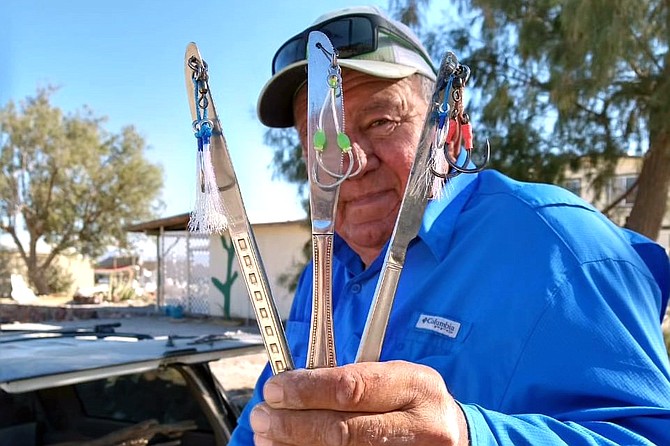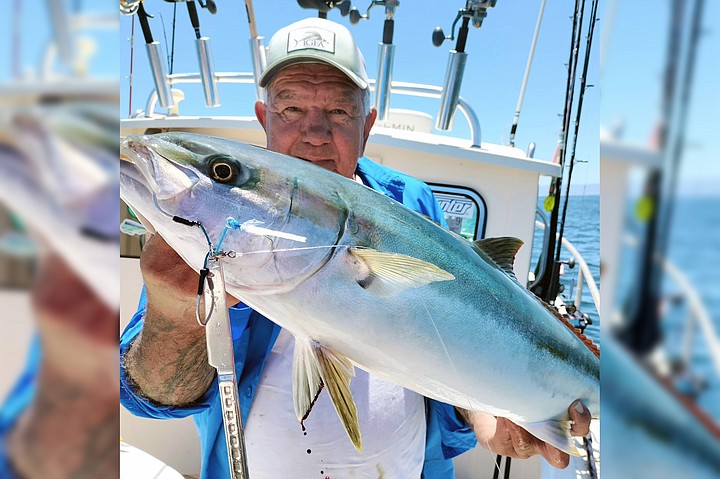 Facebook
Facebook
 X
X
 Instagram
Instagram
 TikTok
TikTok
 Youtube
Youtube

Dock Totals 4/30– 5/13: 3,889 anglers aboard 189 half-day to 3-day trips out of San Diego landings over the past two weeks caught 892 bluefin tuna (up to 180 pounds), 35 bocaccio, 334 bonito, 133 calico bass, 4 halibut, 28 lingcod, 2 mako shark, 11,793 rockfish, 44 sand bass, 25 sanddab, 101 sculpin, 33 sheephead, 11 Spanish jack, 543 whitefish, and 2,409 yellowtail.
Saltwater: Bluefin tuna can be picky around full moon phases, and sure enough leading into and for a few days after May 5th that great start to the season toward the end of April waned a bit through the first couple weeks of May. As of this writing, they are finding them more willing to bite and the trend should continue as weather and overall conditions offshore continue to settle through spring. With the bluefin unwilling, more time was spent on the warming yellowtail bite in the same areas. Rockfish numbers also rose, as the fishing for reds and lingcod on the banks from the lower Nine-Mile Bank down to off Ensenada has been excellent. When the bluefin bite slows down, there is plenty to look for nearby.
Pangas out of Ensenada are already getting into the bluefin action as they are close enough when biting for them to reach, and going south, they are within a five-hour run or so from Point Loma. The tuna are still in the up-and-down mode, that is, they are biting on heavy jigs or sinker rigs deeper in the water column and are not so much so on surface fishing where poppers or kited flyers are used. That will be later in the season, and we’ve a long way to go before this one is over. Yellowtail are also responding well to yoyo irons and fast-pitch butterfly-stile, or knife jigs.
Speaking of knife jigs… Captain Juan Cook is working out of Gonzaga Bay the past couple months as he usually does seasonally. His home port is in San Quintin, where he runs clients his Parker, ‘Slaptail’, out to the banks or San Martin Island for yellowtail, white seabass, rockfish, lingcod, and halibut. While in Gonzaga, they have been getting a lot of yellowtail and beefy-sized groupers mostly on knife jigs. The issue there is those yellows and groupers in the Sea of Cortez love to head straight for reef rock like a freight train, and pound-for-pound, the yellows there seem to pull much harder. You tend to lose a lot of fish, even with the drags buttoned on 60-pound braid and 40-pound leaders. You sometimes have to go with 80 and 50, respectively, to even have a chance.
When so many big fish take you into the rocks, your supply of jigs can dwindle fast, and that’s what happened to Captain Cook this past month. He dropped me a message that if I was heading that way to bring any heavy jigs I had. Well, I hadn’t planned on it, and before I could’ve even got them to him, he found a remedy: Tableware. Butter knives. Just a hole drilled through the tip of the blade of a heavy butter knife and a pair of assist hooks on a ring added, and voila! A true knife jig. This has been done before, and some say the butter knife was the original butterfly/knife jig in the first place.

Though we anglers usually play with making lures more for fun, sometimes it can be a practical solution when the big guys are eating up your hardware. I made some casting spoons out of fork handles when toothy sierra were eating up my shiny chrome lures when living outside of La Paz, and I still have a couple in my box today. The butter knives certainly worked well enough for Juan and his clients. “My friends tell me if you try something once and it works, it's a fluke. If it works two times, it may not be a fluke. If it works three times, it's a fact, and if it works four times, you'll be asking your friends to donate butter knives to make more killer jigs. Yesterday at the Golden Reef I found much to my delight butter knifes with hooks on one end work very well indeed…”
They’re out there, so go get ‘em! (And don’t forget the silverware)


Dock Totals 4/30– 5/13: 3,889 anglers aboard 189 half-day to 3-day trips out of San Diego landings over the past two weeks caught 892 bluefin tuna (up to 180 pounds), 35 bocaccio, 334 bonito, 133 calico bass, 4 halibut, 28 lingcod, 2 mako shark, 11,793 rockfish, 44 sand bass, 25 sanddab, 101 sculpin, 33 sheephead, 11 Spanish jack, 543 whitefish, and 2,409 yellowtail.
Saltwater: Bluefin tuna can be picky around full moon phases, and sure enough leading into and for a few days after May 5th that great start to the season toward the end of April waned a bit through the first couple weeks of May. As of this writing, they are finding them more willing to bite and the trend should continue as weather and overall conditions offshore continue to settle through spring. With the bluefin unwilling, more time was spent on the warming yellowtail bite in the same areas. Rockfish numbers also rose, as the fishing for reds and lingcod on the banks from the lower Nine-Mile Bank down to off Ensenada has been excellent. When the bluefin bite slows down, there is plenty to look for nearby.
Pangas out of Ensenada are already getting into the bluefin action as they are close enough when biting for them to reach, and going south, they are within a five-hour run or so from Point Loma. The tuna are still in the up-and-down mode, that is, they are biting on heavy jigs or sinker rigs deeper in the water column and are not so much so on surface fishing where poppers or kited flyers are used. That will be later in the season, and we’ve a long way to go before this one is over. Yellowtail are also responding well to yoyo irons and fast-pitch butterfly-stile, or knife jigs.
Speaking of knife jigs… Captain Juan Cook is working out of Gonzaga Bay the past couple months as he usually does seasonally. His home port is in San Quintin, where he runs clients his Parker, ‘Slaptail’, out to the banks or San Martin Island for yellowtail, white seabass, rockfish, lingcod, and halibut. While in Gonzaga, they have been getting a lot of yellowtail and beefy-sized groupers mostly on knife jigs. The issue there is those yellows and groupers in the Sea of Cortez love to head straight for reef rock like a freight train, and pound-for-pound, the yellows there seem to pull much harder. You tend to lose a lot of fish, even with the drags buttoned on 60-pound braid and 40-pound leaders. You sometimes have to go with 80 and 50, respectively, to even have a chance.
When so many big fish take you into the rocks, your supply of jigs can dwindle fast, and that’s what happened to Captain Cook this past month. He dropped me a message that if I was heading that way to bring any heavy jigs I had. Well, I hadn’t planned on it, and before I could’ve even got them to him, he found a remedy: Tableware. Butter knives. Just a hole drilled through the tip of the blade of a heavy butter knife and a pair of assist hooks on a ring added, and voila! A true knife jig. This has been done before, and some say the butter knife was the original butterfly/knife jig in the first place.

Though we anglers usually play with making lures more for fun, sometimes it can be a practical solution when the big guys are eating up your hardware. I made some casting spoons out of fork handles when toothy sierra were eating up my shiny chrome lures when living outside of La Paz, and I still have a couple in my box today. The butter knives certainly worked well enough for Juan and his clients. “My friends tell me if you try something once and it works, it's a fluke. If it works two times, it may not be a fluke. If it works three times, it's a fact, and if it works four times, you'll be asking your friends to donate butter knives to make more killer jigs. Yesterday at the Golden Reef I found much to my delight butter knifes with hooks on one end work very well indeed…”
They’re out there, so go get ‘em! (And don’t forget the silverware)
Comments